Winterthur were promoted to the top tier of Swiss football for the first time since their 1984/85 relegation for the 2022/23 campaign — a season in which now-Grasshopper manager Bruno Berner led them to a ninth-place finish, keeping them safe and on track for another Swiss Super League campaign, now with an expanded 12-team format.
This season, Switzerland’s top six advance to the ‘Championship Round’ while the bottom six move to the ‘Relegation Round’; Winterthur, despite having the third-lowest wage bill in Switzerland’s top-flight, per Capology, and the lowest squad value in their division according to Transfermarkt, are challenging for a place in the Championship Round, currently sitting in seventh at the time of writing, two points off sixth-place Luzern.
Under new head coach Patrick Rahmen, Winterthur have been transformed from 2022/23 to 2023/24.
This transformation is visible in their remarkable upturn in the goalscoring department more than anything else, with FCW having bagged the joint-second-most goals (38) of any side in the Swiss Super League this term at the time of writing.
They’ve also generated the third-best xG (33.92) while tallying up the second-best xG per shot (0.122) in their division.
Last season, they ended up with the lowest goalscoring tally of any Swiss Super League side (32), the lowest xG (34.09) and the lowest xG per shot (0.103) — so this is truly a night-and-day comparison between the two campaigns.
As a result, this Patrick Rahmen tactical analysis piece and team-focused scout report will highlight some of the primary reasons for Winterthur’s positive turn in attacking fortunes in 2023/24.
We’ll shed light on exactly where Rahmen’s side is thriving in the offensive department and how they’re achieving their success, with a focused analysis of the 54-year-old ex-FC Basel and Switzerland U21 coach’s tactics as well as some key individuals.
Patrick Rahmen Build-up and ball progression
Our first two sections of this analysis will focus on Winterthur’s in-possession play, with our initial part centring on their build-up play and vital elements of their approach to ball progression.
While FCW have kept just the third-lowest amount of possession (47.2%) in their division this term, they’ve still demonstrated some compelling ideas on the ball, particularly when it comes to slicing through the opposition in a quick and efficient manner.
Their ability in this area has helped them generate the third-most shots (12.87 per 90) in the league this term, as well as the fourth-most touches inside the penalty area (17.69 per 90).
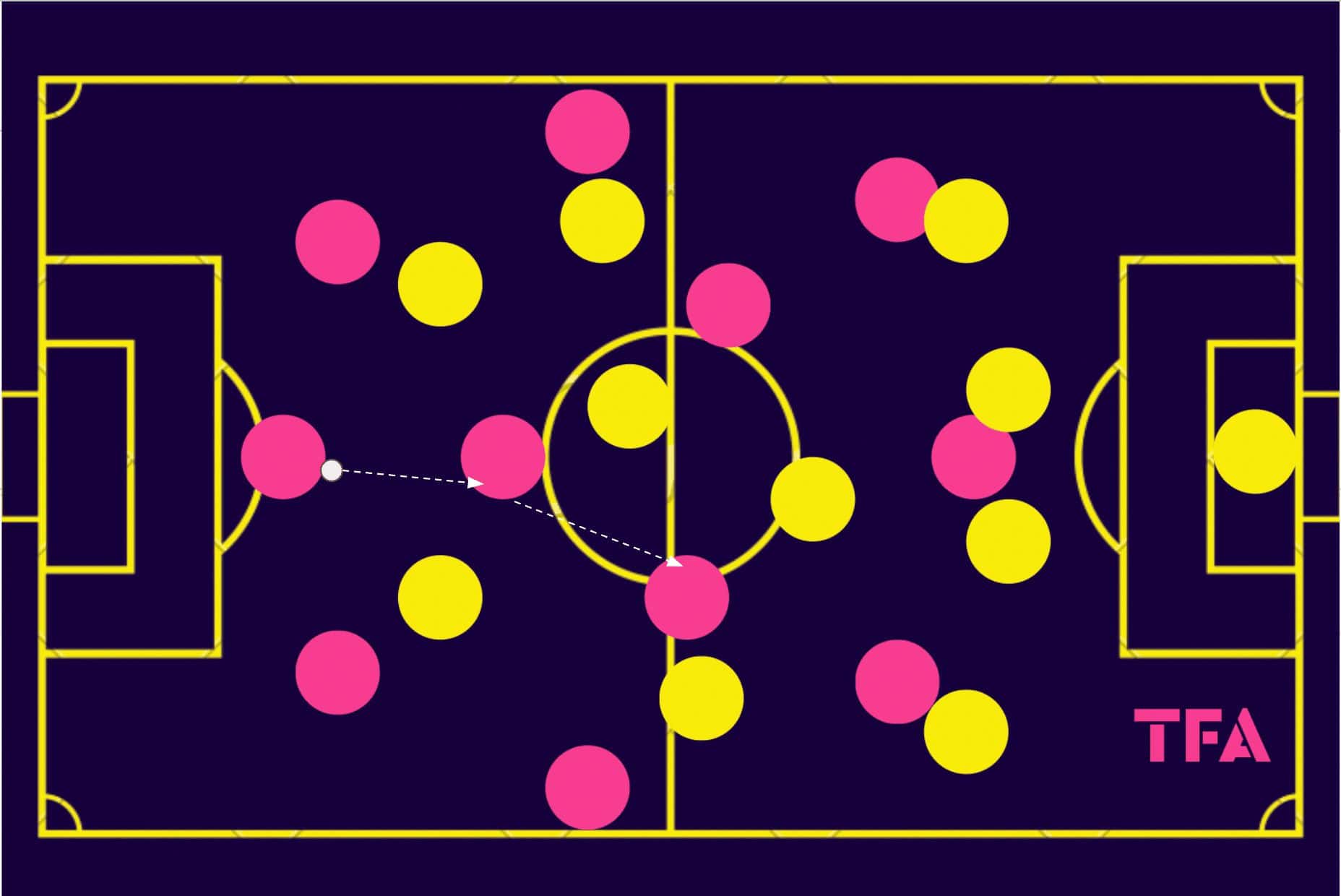
Rahmen primarily sets his Winterthur side up in something of a 4-2-3-1 shape.
In early possession phases, it’s common to see the centre-backs split quite wide while the goalkeeper steps out into the centre of a new back three.
As the centre-backs split wide, they often stretch the opposition’s initial first line(s) of pressure, carving a pathway through to one of the holding midfielders who’ll take the opportunity to drop in centrally and give the ‘keeper an option.
In this case, we can see the holding midfielder receiving before playing the ball on to the ‘10’ who’s dropped out into the right half-space while the other holding midfielder from the initial double-pivot advances to occupy the left half-space, giving the deepest midfielder a potential forward passing option on either side.
However, it’s more important than what happens on the ball here is the way Winterthur’s players position themselves to manipulate the opposition’s press and create pathways upfield — something they’ve tended to do very well this term.
Basil Stillhart Progressive Passes
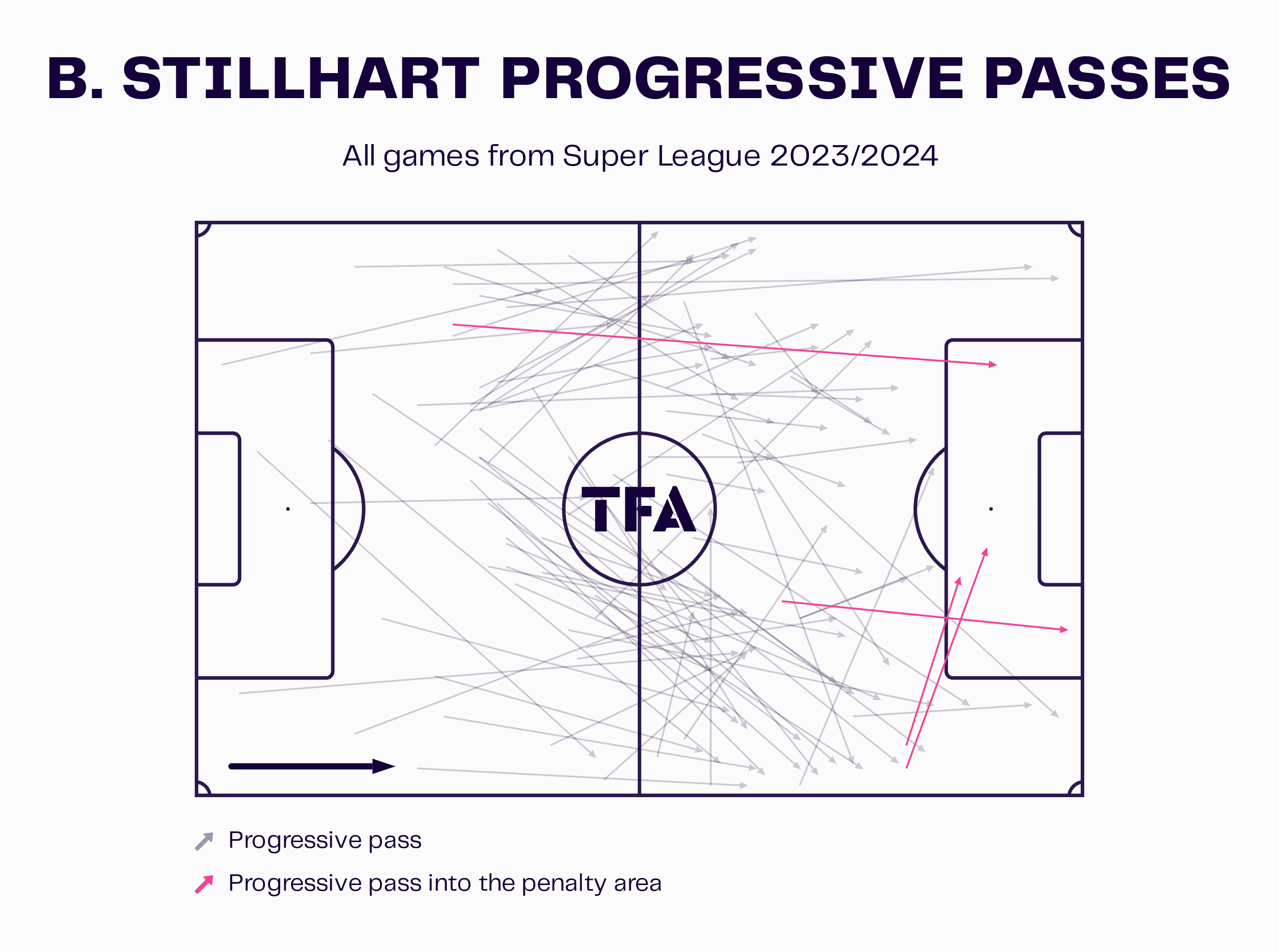
Basil Stillhart joined Winterthur from FC St. Gallen last summer and has quickly established himself as a key figure in FCW’s backline.
His range of passing has helped his side regularly perform exquisite switches of play from the left to isolate their right-winger, Samuel Ballet, 1v1 with opposition full-backs and create an opportunity to advance into the final third.
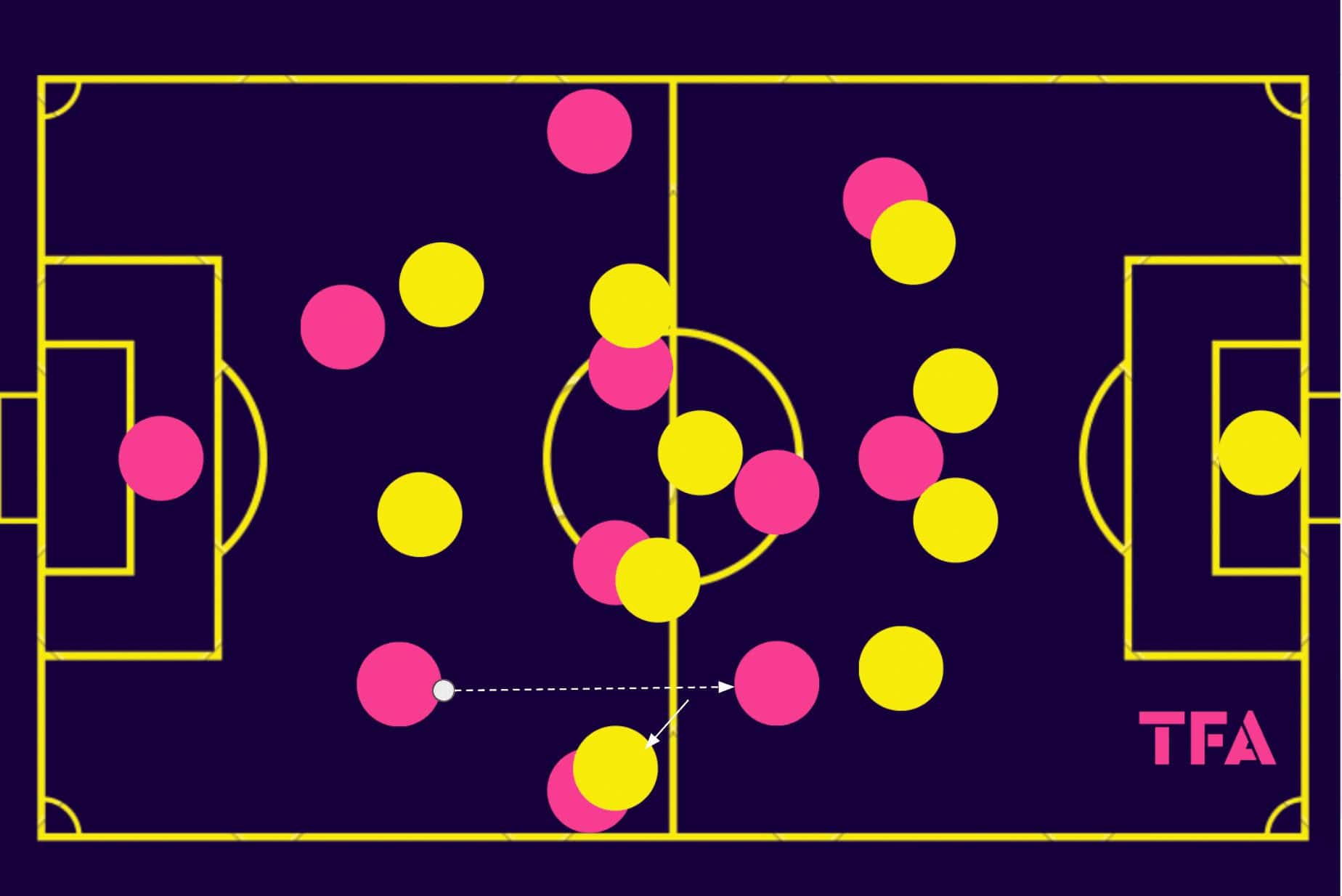
Indeed, Winterthur’s centre-backs, regardless of whether it’s Stillhart on the left or Yannick Schmid on the right, and their composure, passing quality, timing and decision-making have been vitally important for their team in build-up and ball progression this term.
Thanks to the players’ solid decision-making and excellent off-the-ball movement, particularly right-winger Ballet and ‘10’ (typically either Randy Schneider or Matteo Di Giusto), they’ve managed to turn the basic wide diamond structure the 4-2-3-1 naturally forms into a lethal weapon in ball progression this term.
The method is simple — by getting away from the ball-near centre-forward, for instance, in a 4-4-2 or the ball-near winger in a 4-3-3, assuming they press from in-to-out from a narrow position, Winterthur’s centre-back can combine with the ball-near holding midfielder, winger and full-back to overload the opposition in most defensive shapes.
We see an example of this in figure 3.
The opposition’s winger, using the 4-4-2 as an example here, has a big decision to make at this point.
They can cover the passing option out wide, the full-back, but this leaves space directly ahead of the centre-back for the winger to drop into, receive and either turn and run at the full-back 1v1 or combine with, for instance, the ‘10’ and find another path into the final third.
Ballet on the right has done a great job of making these types of movements and losing his marker to give his side a good option a lot this season.
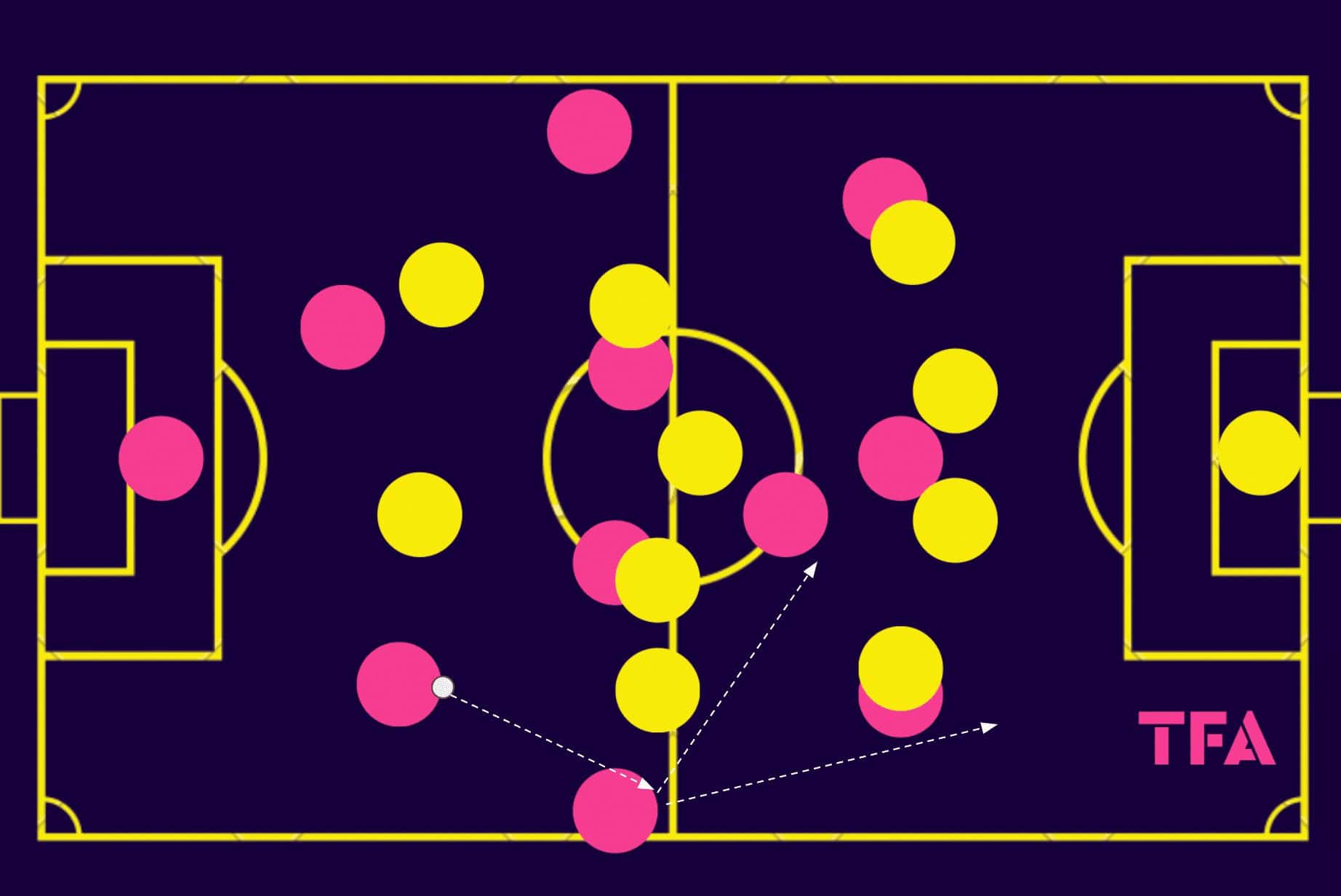
On the other hand, the opposition winger could stay narrower, blocking the potential pass into Ballet.
However, this would then leave the ball to the full-back open, giving him a chance to receive and either play the ball into the ‘10’ — who could receive and either carry it forward to create a 4v4 versus the opposition’s backline or slice the backline open with a through pass — or play it through to Ballet who would be running in behind the full-back on this side, again demonstrating how his movement has been vital for FCW this term.
Silvan Sidler Progressive Passes
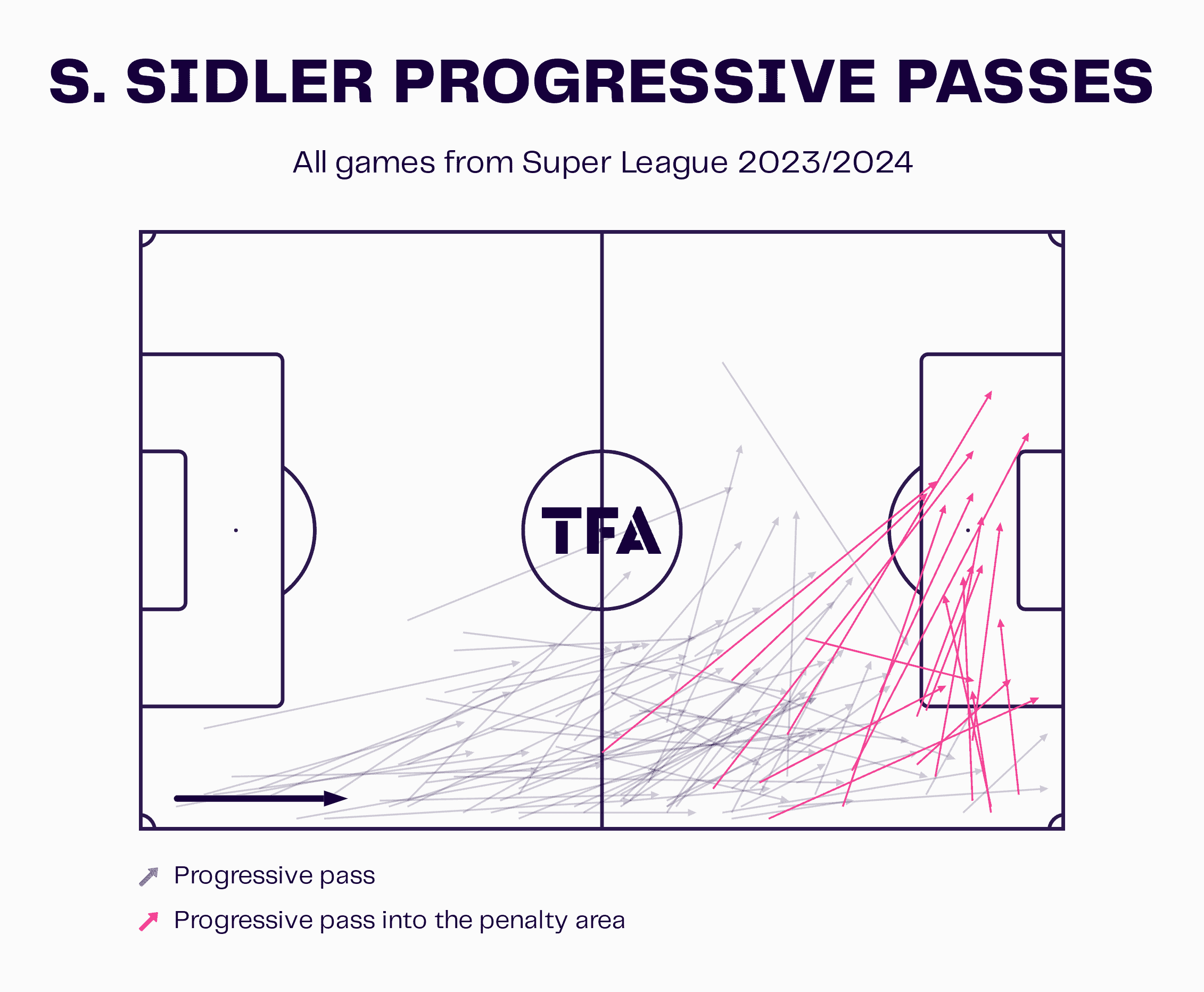
Right-back Silvan Sidler joined Winterthur on a free transfer from Arminia Bielefeld last summer, and that’s proven a wise transfer for FCW thus far, with Sidler proving himself as a massive contributor to his team’s ball progression this season, with plenty of valuable passes made down the line for crucial playmaker Ballet to chase down and get in behind along with accurate passes from wide played into the ‘10’s feet in and around the coveted ‘zone 14’.
Operating as something of a wide deep-lying playmaker, Sidler has quietly become a crucial player as part of Rahmen’s side both in and out of possession in 2023/24, with a lot of Winterthur’s major attacking moves being crafted down the right, as opposed to the left which is a tad quieter.
Chance creation and finishing
Moving on into our next section of analysis, here we’re going to focus on Winterthur’s work in the final third — their chance creation and finishing.
A player we’ve mentioned a fair bit already, 22-year-old Samuel Ballet, has been Winterthur’s key player this season, with the final third really being his domain.
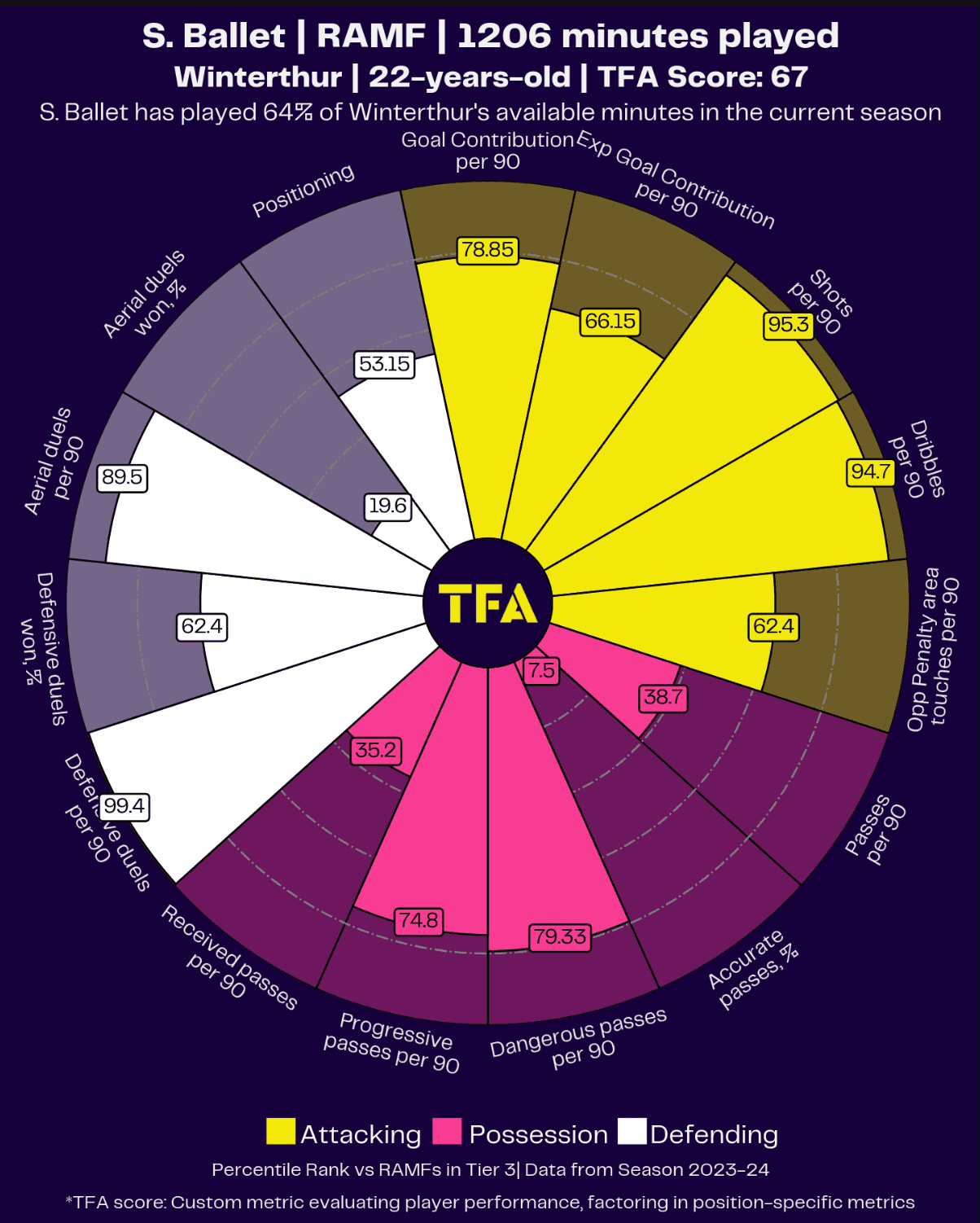
Ballet has offered a lot both in and out of possession, which is everything Rahmen could have asked of his right-winger.
His defensive output has been really high level, as his 99.4 percentile rank in defensive duels per 90 and 62.4 percentile rank in defensive duel success would suggest (all percentile ranks are compared with players in his position from ‘Tier 3’ leagues, with the Swiss Super League, Liga MX, Danish Superliga, Greek Super League, Allsvenskan and Ukrainian VBET Liga all falling into that bracket.
As well as that, the winger’s off-the-ball movement has been a joy to watch, as analysed in the previous section, as it’s helped craft several opportunities for his side to quickly carve through the opposition’s defensive shape and advance into the final third.
Along with that, his 79.33 percentile rank in dangerous passes per 90, a 94.7 percentile rank in dribbles per 90 and 78.85 percentile rank in goal contributions per 90, among others on the viz above, illuminate everything we need to know about this player.
As well as being extremely diligent and effective in his defensive work and crafty in his off-the-ball movement, he’s been something of a machine in terms of his offensive output, with the 22-year-old shining at Swiss Super League level under Patrick Rahmen this season.
Unfortunately for Winterthur fans, Ballet has just been snapped up by Serie B’s Cesc Fabregas-led FC Como for a reported €1.8m — smashing the club’s record transfer sale and rightfully so, given the player’s quality and what he could add at Serie B level — a Tier 5 league according to our rankings — provided he settles in quickly.
He can carry over his form from Winterthur to the Italian second tier.
The FCW faithful will miss seeing this winger on the pitch both for his output and his entertainment value and even with a transfer fee smashing the clubs record sale, we can’t help but feel he will pay for himself quite quickly at Como.
Samuel Ballet Ball Progression
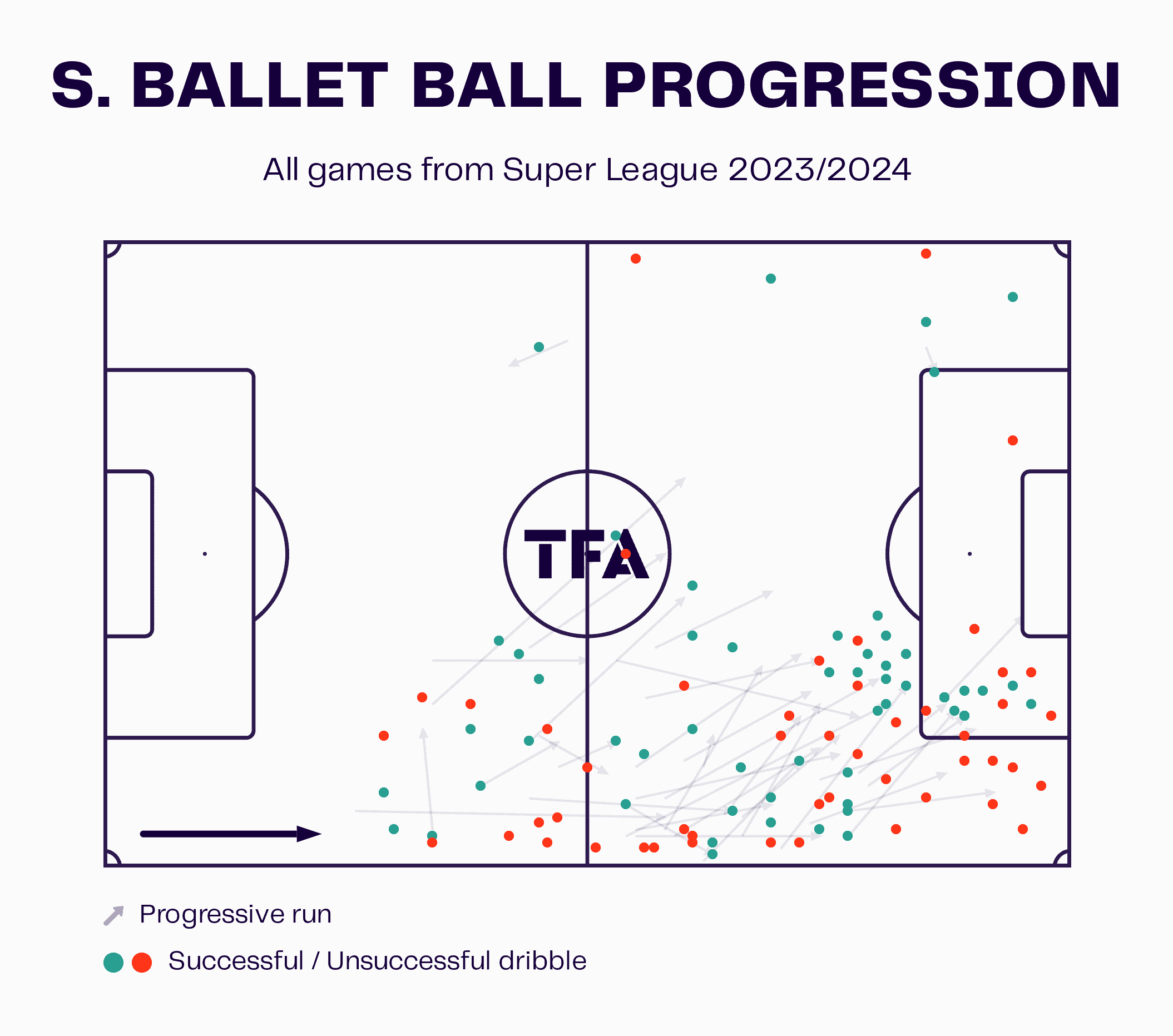
Nevertheless, this article is primarily about Winterthur, not Ballet alone or his move to Como — that may be one for another day — and figure 7 displays how the winger has contributed for FCW in the dribbling department throughout the 2023/24 campaign.
As mentioned, Winterthur have been more active down the right than down the left, particularly when it comes to their chance creation, in 2023/24.
Stillhart’s long switches of play land over on the right to isolate Ballet 1v1 with the full-back.
At the same time, we’ve seen Winterthur orchestrate some excellent passing moves, massively aided by excellent off-the-ball movement to manipulate the opposition’s press as we saw in the previous section of analysis, to set Ballet up for success as he receives in the opposition’s half and breaks away into the final third.
His dribble map above pinpoints where his dribbles this term have occurred, with the largest cluster occurring in the right half-space just on the edge of the area.
Samuel Ballet Shot Assists
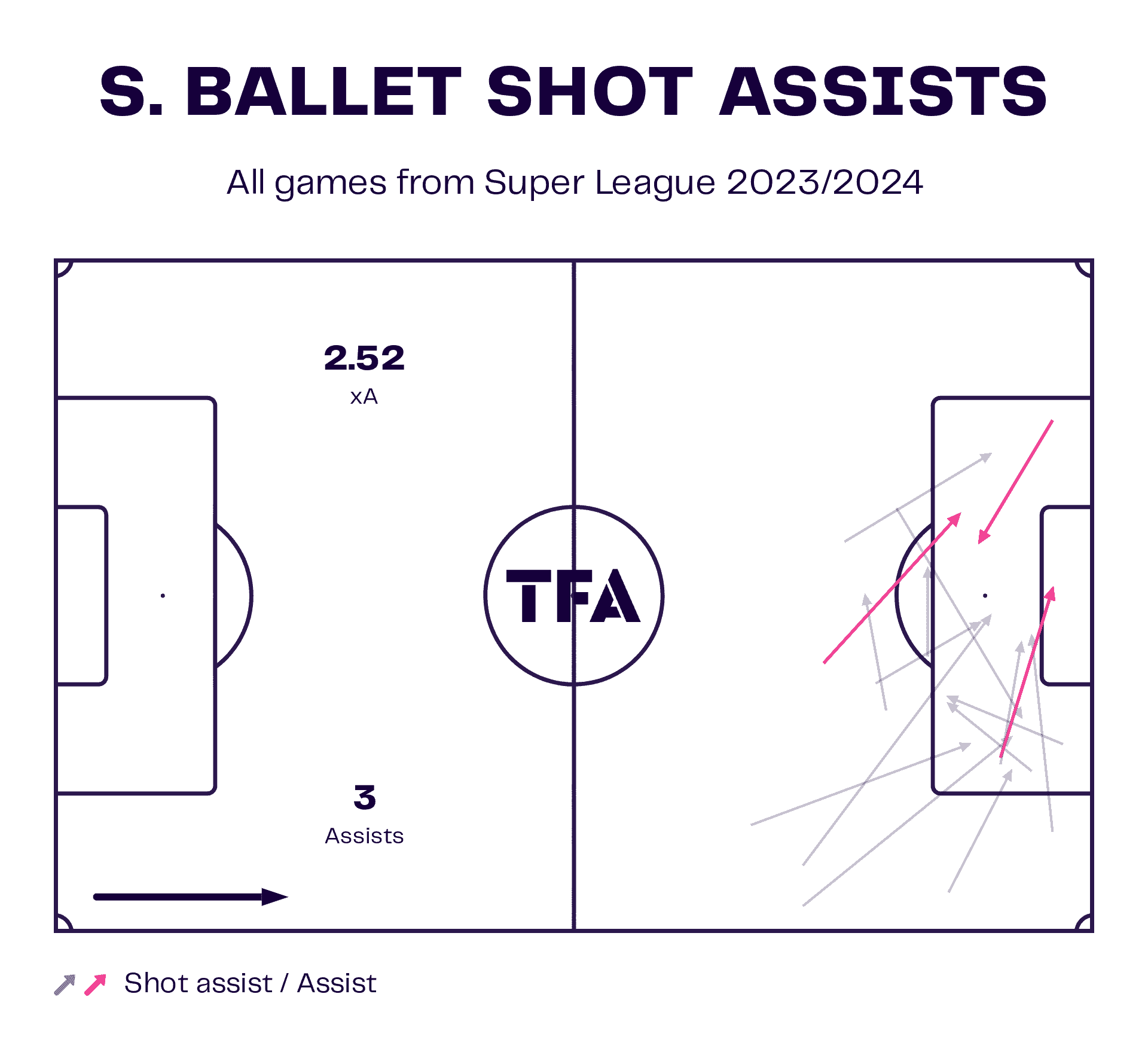
From here, after succeeding in his dribble, it’s common to see the appropriately-named Ballet, adept at dancing past defenders, either exit towards the centre and try to create from a ‘10’ position or take the ball out into a wide crossing position where he can drill one into the box low and hard or perform a cutback towards the edge of the six-yard box.
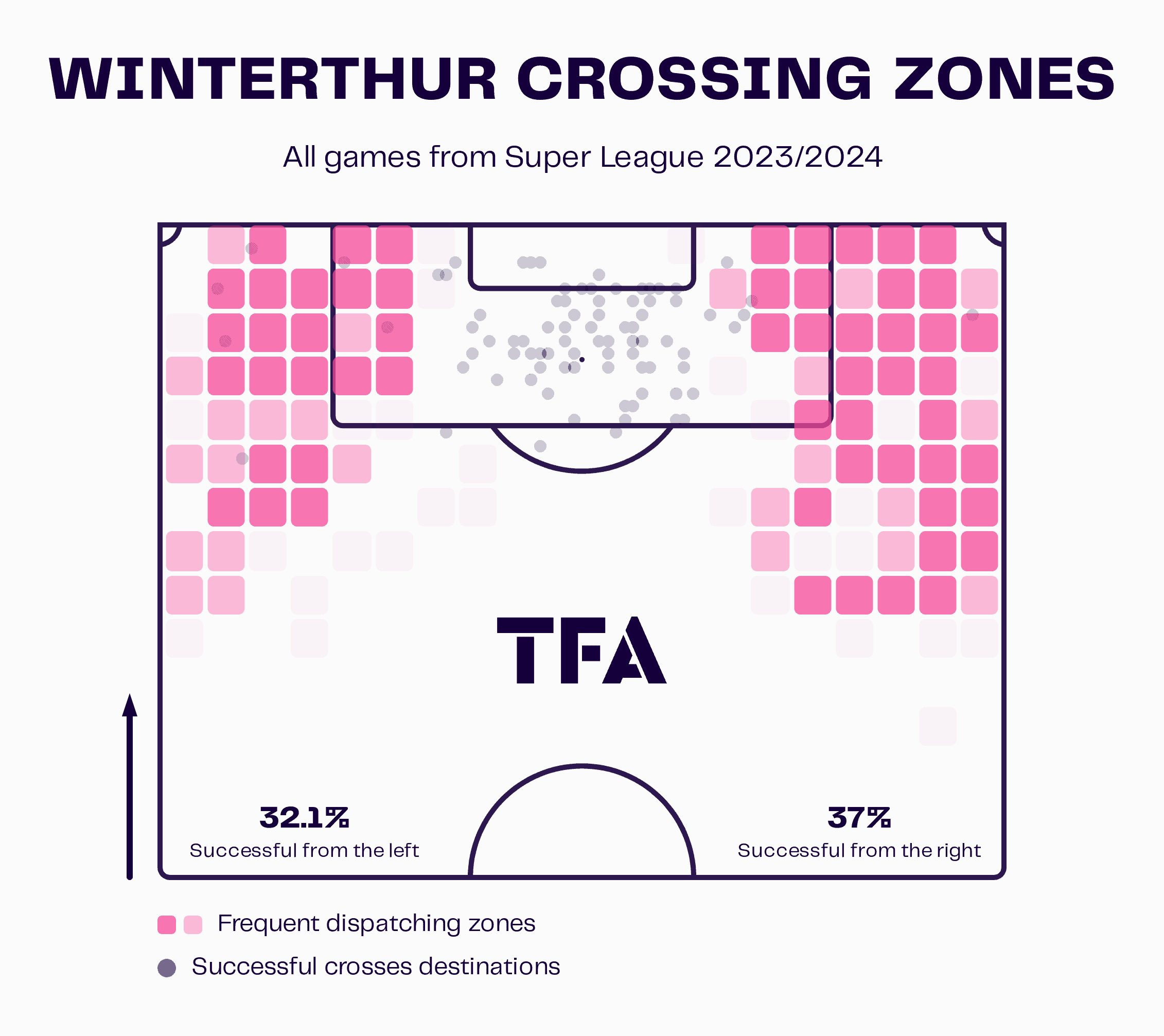
Winterthur have moved towards playing low-driven crosses from either just inside the box or on the edge of the box, as well as cutbacks from the byline a lot more this season, and Ballet, as well as Sayfallah Ltaief — on loan from FC Basel this season and who primarily plays on the left for FCW — have been the chief creators for the team via this method.
Their success with delivering the crosses into the danger zone and generating high-quality chances is a testament to their quality in terms of dribbling and delivery, the striker(s) in the box to free themselves up and get in the right position to take the shot and the prior possession play that crafted the opportunity in the first place.
Aldin Turkes Shot Map
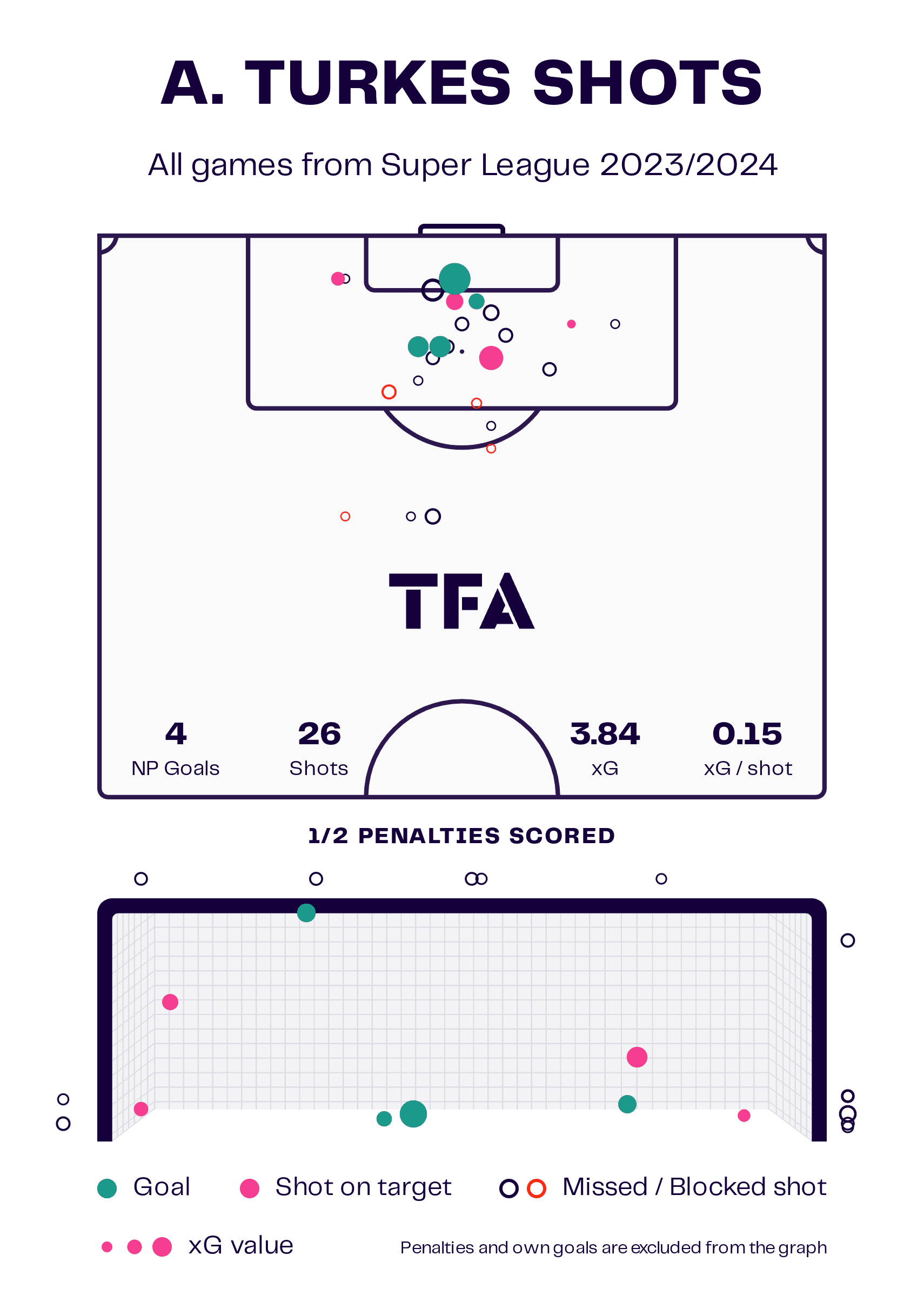
As well as centre-forward Aldin Turkes, who has performed fairly well within Rahmen’s Winterthur system this term after joining FCW on a free transfer from Lausanne-Sport last summer, the ‘10’ and even one of the deep midfielders will arrive late into the penalty box to try and capitalise on the low crosses and cutbacks, with this being a chief method of successful chance creation for the Swiss side this term.
The high quantity of shots around the penalty spot, leading to a decent xG per shot average, is exactly what Rahmen wants to see from his centre-forward as part of this highly efficient attacking unit.
Counterpressing
Our third and final section of analysis here focuses on FCW’s pressing and counterpressing.
Their pressing has also changed dramatically this season compared to last, as is highlighted by their PPDA numbers, which have dropped from 13.25 last season (highest in the league) to average enough this season (10.33).
Furthermore, their challenge intensity has risen from 5.2 to 5.9.
These PPDA and challenge intensity stats both point to one thing: Winterthur are pressing more aggressively under Rahmen than they did last season.
Still, they’ve struggled at the back this term like they did in 2022/23.
However, their pressing has been a useful chance creator — this is its main purpose within Rahmen’s setup.
This is evident from the dangerous recoveries metric, with Winterthur making 88 dangerous recoveries (a recovery leading to a shot within 20 seconds) in the entirety of last season and making 86 already this term — not too shabby.
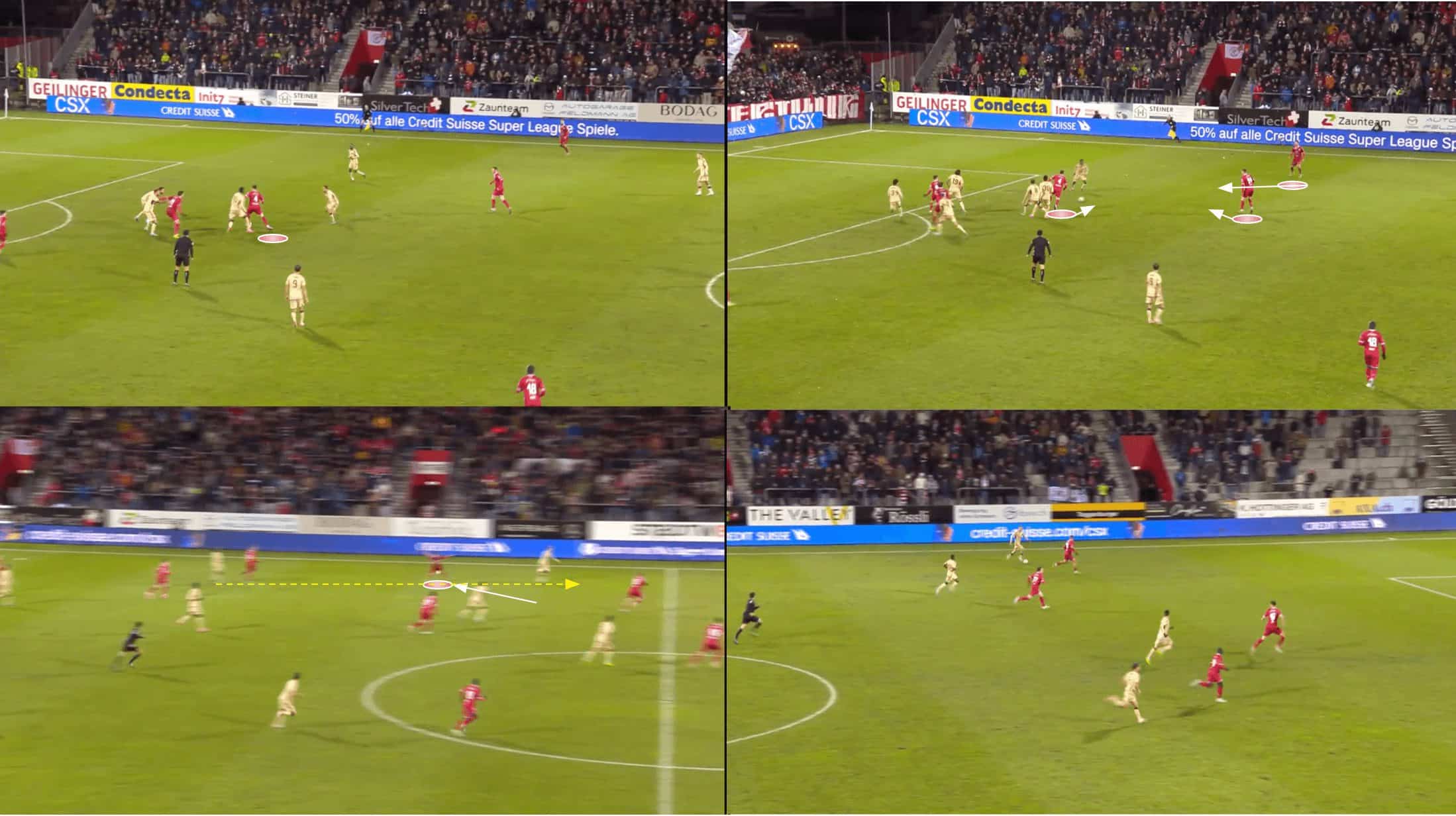
Extremely intense counterpressure has been the main reason for this uptick in dangerous recoveries.
We see an example in figure 11, where the ball is lost just inside the final third and immediately other Winterthun bodies step up to close down the ball-carrier and cut off the nearest passing options to try and force a high turnover that they could then convert into a goalscoring chance.
On this occasion, the ball gets past the right-back, who also steps up, allowing the opposition to get in behind and craft a counterattacking opportunity of their own.
Indeed, it’s typical to see FCW’s full-backs stepping up and pressing with a lot of intensity, which can leave space open behind them for the opposition to attack on the counter, leaving the backline vulnerable, as was the case here.
However, we’d say Winterthur have benefitted more from their aggressive pressing, including the risky role of the full-backs, this term than they’ve suffered from it, even if it does admittedly have its drawbacks.
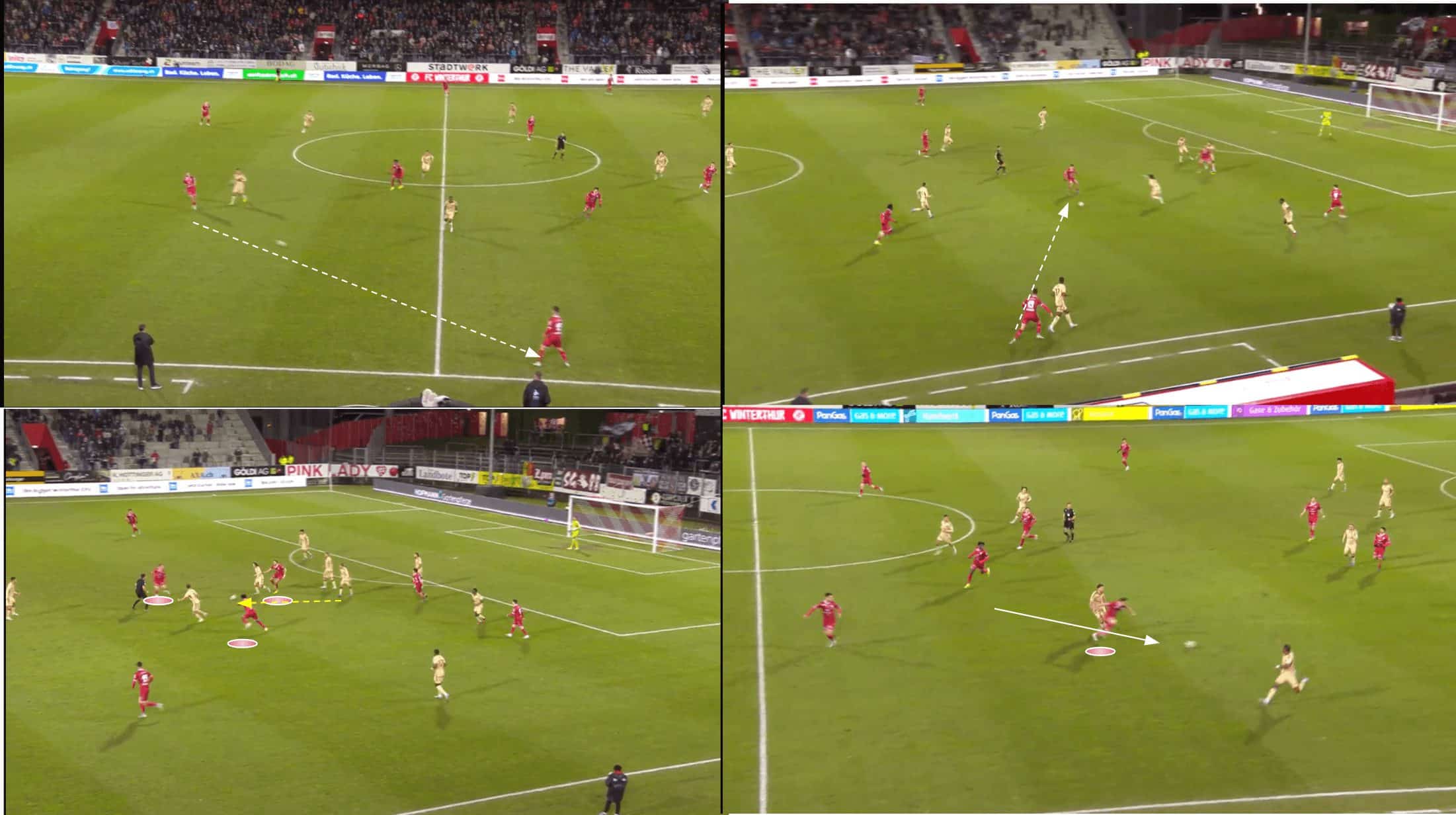
We see another example of Winterthur’s counterpressing versus Servette here in figure 12, though this time it was more successful.
As we see FCW progressing from right centre-back to right-back to ‘10’, a pattern we’ve already established they like to play with, the attacking midfielder gets dispossessed in the centre, but immediate pressure on the ball carrier forces some rushed passes from the opposition, leading to a high turnover in favour of Rahmen’s men.
So basics like bravery in terms of stepping up, committing to duels and fighting for second balls has made a big impact on Winterthur’s attacking numbers this season, essentially! A reminder for all to never neglect the basics as their successful implementation can often prove to be the very visible base for any team’s success at any level.
Conclusion
To conclude this tactical analysis and scout report, we’d just reiterate that though they haven’t been a perfect team, they haven’t kept a good defensive record at all and haven’t been incredibly possession-dominant, Winterthur have been punching well above their weight this season while showing us examples of extremely efficient yet visually pleasing football any team in the world could be proud of both in and out of possession — a testament to the hard work of their players and coaching staff.
How big of a loss will Samuel Ballet be?
And can Rahmen navigate the challenge of dealing with his departure and continue his team’s upward trajectory, perhaps even landing in a top-half spot come the end of the regular season?
It’ll be interesting to watch, but while Ballet has undoubtedly been FCW’s key player this term, he’s not the only one who’s stepped up and looked much better this season under Rahmen than they did last season, so perhaps the collective can still keep Winterthur thriving as they have been!





Comments